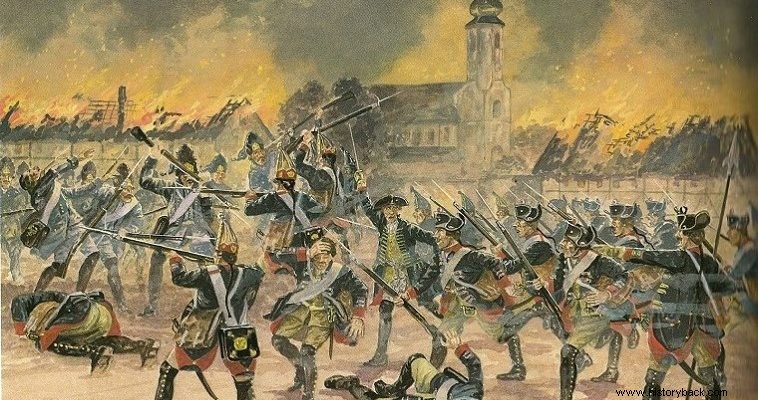
The Prussian Army had no tradition of using light infantry. Unlike the Austrians, who had a large number of snipers from their border with the Ottomans - the famous Gretzners - the Prussians, before Frederick's ascension to the throne, did not have any light infantry.
The bulk of the light corps of the Prussian Army came from the so-called "Free Corps" (freikorps). Foreign mercenaries, former prisoners of war or deserters from other armies were mainly classified in these corps. It is easy to see that the quality of these bodies was not the highest possible. The formation of the free corps began in 1756. However, it would be unfair to claim that the free corps acted only as light infantry.
In many cases these corps acted as normal infantry of the line. This fact makes the freikorps the first dual-role infantry corps in modern European military history. Each of the 22 freikorps that served in the Seven Years' War was "owned" by a, usually Prussian, noble. He determined the composition, organization and armament of his body. There were corps that included in their ranks exclusively cavalry or exclusively infantry or even mixed "legions", with divisions of all arms.
Their men, officers and soldiers, at least 90%, were foreigners, from all corners of Europe. The officers in particular were, for the most part, adventurers of petty nobility who had willingly or unwillingly left their homelands in search of better fortunes. It is surprising, however, that men from countries with which Prussia was at war served in the free corps.
The first freikorps was formed in 1756 by Francisco de La Noble , a former officer in the army of the Palatinate - hostile to Prussia. The corps originally had the strength of a single battalion. Later, however, a second battalion was formed as well as a detachment of hunters. The latter were armed with rifled rifles. The other men of the corps were equipped with a light musket (fuzil), bayonet and a short sword. This corps took the name Freikorps de La Noble , by its commander and operated with remarkable success during the war.
The second light body was mixed , since it included in its ranks also ulama of hussars. Its founder and commander was a Saxon, Johann von Mayer . The corps originally had an infantry battalion. By 1760, however, he managed to line up two battalions of infantry, a detachment of hunters and a ulama of hussars. This particular corps included in its ranks many Saxon soldiers, who did not particularly like the Prussians, who had overthrown the state of Saxony.
This also had an impact on the unit's behavior on the battlefield. The first battalion captured it twice, the whole putting up a typical resistance. The same applies to Freikorps Kalben , which was formed in Saxony by the nobleman of the same name. And this corps extended two battalions of infantry and a detachment of hussars. The Angelelli Body it was a "creation" of the Dutchman Ludovic d'Angelelli. It had a single infantry battalion.
The "French" body Krossinho it also had a single infantry battalion. This battalion did not hesitate to surrender to the Austrians without a fight. Eventually the captured battalion was exchanged and its personnel joined the 2nd Battalion of the von Woods Corps. In 1758 the bodies of von Rapin were also formed and von Woods . Both ended up fielding two battalions. Their personnel came from French prisoners and deserters.
At the beginning of 1758, the famous Freikorps di Verger was formed. which from March of the same year was renamed the Quintus Isilius Corps. Its commander was the French-born historian Charles Guisard, whom Frederick called Quintus Isilius - a corruption of the name of the Roman officer Quintus Caecilius, who had fought at Pharsala in 48 BC. The history buff Frederick had developed a close friendly relationship with Guisard, a fact that also had an impact on the latter's Corps. The Corps de Verger was one of the best and almost always served under Frederick's command. By 1761 it had grown to have three battalions of infantry and a company of hunters.
The corps formed by Count von Ord was also remarkable . The corps had two battalions of infantry. Another mixed body it was that of the "Prussian Volunteers" , which was founded in 1759 by the Prussian noble von Trimbach. The corps originally consisted of an infantry battalion, a company of hunters and a company of dragoons. Later, however, the hunters were converted into grenadiers, a second infantry battalion was formed, and the dragoon regiment was replaced by two hussar regiments.
In 1759, the famous corps of von Kleist was formed , which was really a legion with units of all arms. Freikorps von Kleist was the strongest, best organized and trained corps. It was the only one that had the honor of carrying a flag. It had two battalions of infantry, two companies of hunters, a regiment of dragoons of 10 mils, a regiment of hussars also of 10 mils, a detachment of ulanas (lancers) and a light artillery.
In 1761 the Corps of Frei-Grenadiers of von Schoni was formed . It consisted of 5 companies of grenadiers and three companies of hussars. An equally formidable corps was that of the "British Legion" . His men came from every corner of Europe. Until 1762 the corps was financed by Britain, hence the name.
Other short-lived and not particularly noteworthy bodies were that of de Geney (a battalion and a company of hussars), the corps of von Sasch (a battalion and detachment of hunters), the "Swiss Corps" Heer (one company of grenadiers and two companies of riflemen), the French corps Bequinol (a battalion), the Corps of "Foreign Volunteers" la Bandy (a battalion), the Gshrai Corps (six infantry companies, six dragoons) and the mixed "Black Legion" (three companies of grenadiers, one company of chasseurs, detachments of dragoons, hussars and hussars).
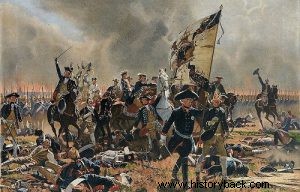
Frederick the Great with the flag in his hand.
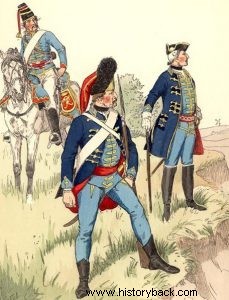
Officer, grenadier and hussar of the von Schoni corps.
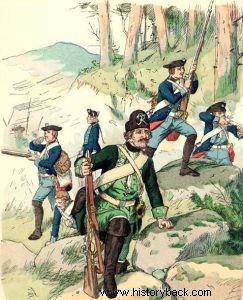
Musketeers and Hunter of Le Noble's corps.
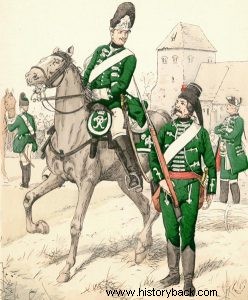
Dragoon, infantry and (in the background), an officer of the best free corps, this von Kleist.
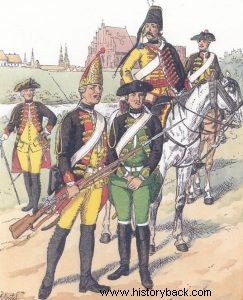
Men of the "Black Legion".
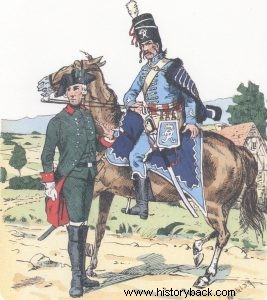
Men of the von Mayer corpus.
